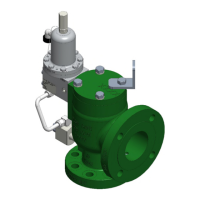INSTALLATION, OPERATION, &
MAINTENANCE MANUAL
TITLE: F7000 / 8000 Series Rev. V
Pilot-Operated Safety Relief Valve Page 28 of 41
5.3 F100 PILOT VALVE ADJUSTMENT (See Illustrations on Pages 15 and 27)
1) The set pressure for the F100 high-pressure pilot valve may be adjusted by turning the pressure
adjusting (PA) screw, or changing springs or corresponding spacer combinations. Springs and
spacers are matched in three different set pressure ranges: 4 to 136 psig, 100 to 405 psig, and
293 to 720 psig. Contact Flow Safe to verify the proper spring and spacer combination.
2) Attach pilot valve assembly to the test tank with the cap removed and the PA screw turned in to
approximately where the set point is believed to be.
3) Slowly increase inlet pressure to set point, as defined in 5.1.
4) Dome pressure and inlet pressure should increase together until first bubble (or first flow of liquid)
from the pilot exhaust occurs (at approx. 95 - 97% of set pressure for ASME settings), and then
dome pressure should begin decreasing.
5) If dome pressure does not drop to the specified value within 3 – 5% after pilot first exhaust, adjust
the PA screw as necessary. If further adjustments fail to achieve the required dome reduction, stop
the test, disassemble the pilot valve, and inspect parts as required.
6) After dome pressure drops to the specified value (or lower), slowly lower the test tank pressure
until the pilot closes and the exhaust flow stops. At this point dome pressure and inlet pressure will
equalize. Pilot leakage should stop at an inlet pressure of no less than 90% of set pressure for
ASME settings, or 95% for DOT settings.
7) Increase the test tank pressure slowly until the dome pressure drops again. Continue flowing test
fluid to the pilot valve and check for modulation.
8) When the set pressure has been adjusted to the desired settings, tighten the PA screw lock nut.
9) Install and tighten the cap onto the PA screw.
10) Repeat the test to verify repeatable performance.
11) With the pilot valve assembly pressurized to just under set point, inspect all tubing, connections,
and fasteners for leaks.
5.4 F200 PILOT VALVE ADJUSTMENT (See Illustrations on Pages 17 and 27)
1) The set pressure for the F200 Pilot Valve may be adjusted only by turning the pressure adjusting
(PA) screw or changing springs. Contact Flow Safe to verify the proper spring for the desired set
pressure.
2) Attach pilot valve assembly to the test tank with the cap removed and the pressure adjustment
screw turned in to above where the set point is believed to be.
3) Apply pressure to the test tank up to slightly less than the designated set pressure.
4) Slowly increase the test tank pressure toward the set point. The dome pressure gauge should
increase at the same rate and reading as the test tank gauge.
5) At the designated set pressure value, slowly turn the PA screw counterclockwise until the pilot
valve assembly exhausts. Check that the dome reservoir gauge drops to 0 (zero) psig.
6) If the dome pressure drops to zero, slowly lower the test tank pressure until the pilot closes and the
dome gauge recovers back to the inlet pressure value. If the dome pressure does not drop to zero,
stop the test and disassemble and inspect the parts.
7) At the point of dome gauge recovery, record the test tank pressure gauge reading. The difference
between this pressure and set point will be the pilot valve blowdown.
8) The valve blowdown should be approximately 7% of set pressure, or as specified. To shorten
blowdown turn the bushing into the valve body (clockwise). To lengthen blowdown turn the
bushing out of the valve body (counterclockwise). Blowdown can also be adjusted by holding the
bushing stationary and turning the valve body. The bushing jam nut must be tightened after each
blowdown adjustment.
9) When the set pressure and blowdown have been adjusted to the desired settings, tighten the PA
screw lock nut and bushing jam nut.
10) Install and tighten the cap onto the PA screw.
11) Repeat the test to verify repeatable performance.

